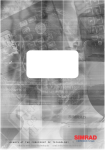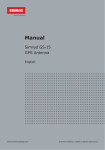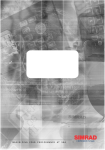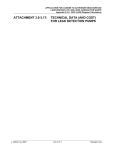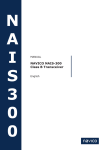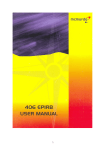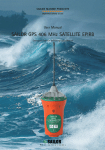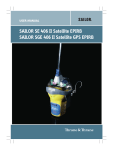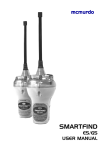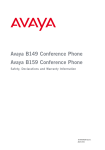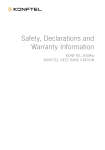Download Simrad Axis 200 Technical data
Transcript
M A X I M I Z I N G Y O U R P E R F O R M A N C E A T S E A M A N U A L Simrad HT50/51/53 & Axis 50 GMDSS Handheld VHF Radios HT50/HT51/HT53 & Axis 50 GMDSS © 2005 Simrad Ltd The technical data, information, and illustrations contained in this publication were to the best of our knowledge correct at the time of going to print. We reserve the right to change specifications, equipment, installation, and maintenance instructions without notice as part of our policy of continual development and improvement. No part of this publication may be reproduced, stored in a retrieval system, or transmitted in any form, electronic, or otherwise, without prior permission from Simrad Ltd. No liability can be accepted for any inaccuracies or omissions in the publication. Although every care has been taken to make it as complete and accurate as possible. IV Part No. E03766 Issue 3.0 22-Jun-05 CR Instruction Manual 1 GENERAL 1.1 Introduction . . . . . . . . . . . . . . . . . . . . . . . . . . . . . . . . . . . . 7 2 OPERATION 2.1 Controls ...................................... 8 2.2 Selecting secondary channel sets . . . . . . . . . . . . . . . . . 11 2.3 Disable/enable key beep . . . . . . . . . . . . . . . . . . . . . . . . . . 12 2.4 Keypad lock . . . . . . . . . . . . . . . . . . . . . . . . . . . . . . . . . . . 12 2.5 Removing and attaching the battery . . . . . . . . . . . . . . . . . . 12 2.6 Charger options . . . . . . . . . . . . . . . . . . . . . . . . . . . . . . . . . 13 2.7 Charging of batteries . . . . . . . . . . . . . . . . . . . . . . . . . . . . . 13 2.8 Battery level indicator . . . . . . . . . . . . . . . . . . . . . . . . . . . . 13 2.9 The HT51/HT53 accessory socket . . . . . . . . . . . . . . . . . . . 14 3 APPENDIX E03766 Issue 3.0 3.1 Licensing . . . . . . . . . . . . . . . . . . . . . . . . . . . . . . . . . . . . . . 15 3.2 Radio frequency exposure guidelines . . . . . . . . . . . . . . . . . 15 3.3 Antenna . . . . . . . . . . . . . . . . . . . . . . . . . . . . . . . . . . . . . . . 16 3.4 Transmission range . . . . . . . . . . . . . . . . . . . . . . . . . . . . . . 16 3.5 Channel frequencies ............................. 17 3.6 Battery life guidelines . . . . . . . . . . . . . . . . . . . . . . . . . . . . 18 3.7 Troubleshooting . . . . . . . . . . . . . . . . . . . . . . . . . . . . . . . . . 19 3.8 Spares & accessories . . . . . . . . . . . . . . . . . . . . . . . . . . . . . 20 3.9 Technical specification ........................... 21 3.10 Declaration of Conformity . . . . . . . . . . . . . . . . . . . . . . . . 22 3.11 Service & warranty . . . . . . . . . . . . . . . . . . . . . . . . . . . . . 23 V Instruction Manual 1 GENERAL 1.1 Introduction The Simrad waterproof handheld VHF range comprises three models: • The HT50 VHF radio is designed for leisure and light commercial use, and meets or exceeds stringent International Regulations EN301-178. • The HT51 model has all the features of the HT50, but includes an accessory socket for use with fistmikes, headsets, and other third party accessories. • The HT53 model is designed with a high-strength connector for users who have rigorous demands of their radios. The features, functionality, and operation of the HT53 are identical to the HT50. • The Axis 50 model for GMDSS convention vessels conforms to Pan European specification ETS300-225 for the use of radios for Safety at Sea. All models are waterproof to IP67 standard. HT50 waterproof handheld VHF Please note that regulations vary from country to country. Simrad sets are approved specifically by the countries in which they are sold. Consequently, there may be differences in the programming of sets bought in different countries and, therefore, in their associated manuals. If using the radio outside the country of purchase, it is vital to check that the set conforms to local regulations before use. Thank you for choosing Simrad! If you are pleased with your radio, we hope you will be interested in our range of marine electronic equipment, which is manufactured to the same high standards as the HT50. Please contact your nearest Simrad agent for a catalog showing our increasing range of high-tech navigational instruments, GPS, Autopilots, Radar, Echosounders, Chartplotters, and VHF radio sets. Further and more detailed information can also be found online at: www.simrad.com. Simrad operate a policy of continual development and reserve the right to alter and improve the specification of their products without notice. AxisTM is a registered trademark of Simrad Ltd. E03766 Issue 3.0 7 HT50/HT51/HT53 & Axis 50 GMDSS 2 OPERATION 2.1 Controls The location of the controls for the HT50 series are shown in Fig 2.1 below. Functions: 1 On / Off 2 High / Low power, Keypad lock 3 PTT (Push-To-Talk button) 4 Volume mode select 5 Squelch mode select 6 Up key 7 Down key 8 Scan mode 9 Dual Watch / Tri-Watch 10 Select Priority / Personal channel 11 Backlight On / Off & Light mode select 1 2 3 5 4 7 6 9 8 11 10 Fig 2.1 - HT50 controls 8 E03766 Issue 3.0 Instruction Manual Pressing and holding certain keys will access additional functions. These are indicated by a double beep, or a triple beep if held for longer (Table 1). Key Press 1x Press 2x Press & hold Press & hold Triple Beep Double Beep Hold during Power Up VOL Select Volume mode Select secondary channel set* SQ Select Squelch mode Disable / enable first key beep Standard mode Channel Up / Down ▲ ▼ Volume mode Volume Up / Down Squelch mode Squelch Up / Down Light mode Light level Up / Down Add / delete Inhibit / enable channel from Scan All Channels selected channel Memory Scan from scan SCAN Memory Scan D/W Dual Watch Tri-Watch Select channel 16 Select Personal channel 16 Set Personal channel Select Light mode Backlight On/Off Hi/Lo Select 1 or 5 Watts Engage / disable keypad lock *If available Table 1 - Additional functions, overview E03766 Issue 3.0 9 HT50/HT51/HT53 & Axis 50 GMDSS a c b f g e d h i a b c d e f g h i Bar graph – Power up Battery level Standby Battery level Transmit Battery level Volume mode Volume level Squelch mode Squelch level pressed Backlight level Personal channel indicator Channel selected Receiving or transmitting indicator High or Low power indicator Function indicator Selected channel stored in memory Channel inhibited from scan Scan mode selected Fig 2.2 - HT50 display functions On/Off (1) Press to turn the HT50 on. To turn the radio off, press and hold the key for approximately 2 seconds. This is to avoid accidental power off. Hi/Lo (2) Toggles between high and low transmit power (see specification section 3.9). Use the low setting over short ranges to preserve battery power. VOL – Volume (4) & SQ – Squelch (5) Press to select Volume or Squelch mode then use the ▲ and ▼ keys to adjust the level. The display shows “VOL” or “SQL” for 3 seconds – if ▲ or ▼ are not pressed within this time, their function reverts to channel select. ▲ / ▼ (6 & 7) These keys will change the selected channel. Pressing VOL, SQ, or , then ▲ or ▼ within 3 seconds will adjust the volume, squelch, or backlighting level respectively. The bargraph will indicate the level selected. SCAN mode (8) Scans through the channels stored in the channel memory (display shows “MEM SCAN”). • Select channel and press twice to add to or delete from Memory Scan (display shows “ENT” or “DEL” respectively). 10 E03766 Issue 3.0 Instruction Manual • The icon indicates that the selected channel is included in Memory Scan. • Press and hold until double beep sounds to scan all channels (display shows “SCAN”). • Press and hold until triple beep sounds to inhibit/enable selected channel from scan (display shows “INH” or “ENA” respectively). The icon indicates the channel is inhibited. D/W - Dual Watch & T/W – Tri-Watch (9) • Press to select Dual Watch of selected channel and Ch16 (the display shows “D/W”). • Press and hold until double beep sounds for Tri-Watch – selected channel, personal channel, and channel 16 (the display shows “T/W”). 16 - Channel 16 / Personal Channel (10) • Press to select channel 16. • Press and hold until double beep to select personal channel (display shows ). • Press and hold for three beeps to set selected channel as the personal channel. Keep VOL pressed - Backlight (11) • Press to turn on and off. Use ▲/▼ to adjust the backlighting level (five levels available). The bargraph indicates the backlighting level. • The battery save function turns the backlighting off if no key is pressed after 20 seconds. Press any key (except or ) to turn the light on again. 2.2 Selecting secondary channel sets In countries where it is permitted, holding VOL down while turning the radio on will enable the radio to operate on a secondary set of channels (Fig 2.3). Where the display will normally show “INT” (International channel set) on the bottom line, this will show “USA” for USA channels, “CAN” for Canadian channels, etc. • Channel sets available will depend on which country the radio is programmed for use in. This function will only be available if permitted in the country of purchase (for details refer to sections 3.1 and 3.5). • The radio will revert to International channels if it is Fig 2.3 - Selecting alternative switched off, then on again. channel sets E03766 Issue 3.0 11 HT50/HT51/HT53 & Axis 50 GMDSS 2.3 Disable/enable key beep The HT50 beeps every time a key is pressed to confirm operation. To disable the key beep, press and hold SQ while turning the set on. Repeat this procedure to turn the key beep on again. Second level functions (such as All Channel Scan, Tri-Watch, etc.) will still be indicated by a beep, even if the key beep is disabled. 2.4 Keypad lock The HT50 keypad can be locked to prevent accidentally pressing keys while in a pocket, for example. To lock the keypad, press and hold the Hi/Lo key. The HT50 will beep twice and any key pressed will not function – “LOCK” will appear in the display. To disengage the keypad lock, press and hold Hi/Lo again. Note The PTT key will still function when the keypad lock is on, allowing transmitting and receiving as normal. Note This function is not available with the Axis 50 GMDSS models (yellow case). 2.5 Removing and attaching the battery The HT50 is supplied with a 1200mAh NiMH battery (part no. NH12). The Axis 50 GMDSS radio has two battery options: an 850mAh NiCad (part no. NC08) or a non-rechargeable lithium battery (part no. LTB3). The batteries are supplied with a label across the contacts to prevent accidental discharge while in the box. This label should be removed before use. To remove the battery, lift the two locking clips holding the battery pack in place (Fig 2.4). When reattaching, ensure the two locating pegs on the top of the battery are located into the slots in the radio and that the two locking clips have both engaged. Fig 2.4 - Battery pack removal Note 12 The set is fully waterproof, even with the battery removed, but it is recommended that any moisture on the top of the battery or in the battery compartment is wiped clear before attaching to prevent the water creating a conductive path between the contacts and reducing battery life. Axis 50 batteries cannot be used with an HT50, and vice versa. E03766 Issue 3.0 Instruction Manual 2.6 Charger options The HT50 is supplied with a TC50 trickle charger that will accept the whole radio or the battery only. The TC50 runs from a 12.6V–15.5V DC supply or from AC mains with an appropriate optional adaptor/power supply. Charging with the trickle charger takes approximately 12–16 hours. There is also a rapid charger available (RC50) which will charge the battery within 1 1/2 hours. 2.7 Charging of batteries To charge the NiCad and NiMH battery packs, insert the battery or radio into the charger ensuring that any moisture is wiped from the contacts on the back of the battery pack. The TC50 will trickle charge the battery to full capacity (Fig 2.5). The RC50 will rapid charge the battery until it is fully charged and then automatically switch to maintenance charge. Fig 2.5 - Battery charger Caution • Note that batteries are supplied uncharged and must be fully charged before use. • Fully charge the battery when not in use, though it may lose some of its charge after several months of storage. • Do not charge at temperatures below 0°C or above 40°C. • Turn off radio when charging the battery. • Regularly discharge the battery totally – repeated recharging of the battery while it is only partly discharged may create a ‘memory effect’, preventing it reaching full charge. • Dispose of used batteries carefully. The contents of the batteries could be harmful to the environment. • Never expose to a naked flame. The LTB3 lithium battery is not rechargeable and under no circumstances should any attempt be made to recharge it. Replacement batteries can be ordered from your local Simrad Agent. 2.8 Battery level indicator Except when adjusting the volume or squelch level, the bar graph on the display shows the battery charge level (Fig 2.6). This indicates the voltage at the battery terminals, not necessarily the charge stored. Ten or nine bars indicate a fully charged battery, three or four bars mean the battery is almost drained. Fig 2.6 - Battery level indicator E03766 Issue 3.0 A more accurate indication of the battery state will be obtained by transmitting briefly on high power. Do not use Ch 16 for this purpose. 13 HT50/HT51/HT53 & Axis 50 GMDSS When using a lithium battery pack, the low-level battery indicator may flash under transmit conditions. This does not necessarily reflect the charge level remaining in the battery, as it is due to the different voltage characteristics of a lithium battery pack under load. 2.9 The HT51/HT53 accessory socket The HT51/HT53 features an accessory socket (Fig 2.7) for use with fistmikes, headsets, and boom-mikes, etc. The features, functionality, and operation of the HT51/HT53 are identical to the HT50. Only accessories made specifically for use with the HT51/ HT53 should be connected – incompatible accessories could damage the radio and invalidate the warranty. Switch off the radio before connecting an accessory to the socket. Note that the HT51/HT53’s internal speaker, microphone, and PTT button are disabled when the accessory is connected – these functions are transferred to the accessory. For details of compatible accessories available, please contact your Simrad Distributor or the Simrad Preferred Supplier: Atlantic Instruments The Coach House Trefor Holyhead Anglesey LL65 1LZ United Kingdom Fig 2.7 - HT51 with accessory socket 14 Contact: Mobile: Phone: Fax: E-mail: Website: Charles Mortlock +44 (0)7761 494384 +44 (0)1407 720513 +44 (0)1407 720616 [email protected] www.atlanticuk.com E03766 Issue 3.0 Instruction Manual 3 APPENDIX 3.1 Licensing Prior to use please check the national licensing requirements for operators. Note In the UK license applications and queries should be made to the following authority: Ship Radio Licencing Radio Licencing Centre The Post Office P.O. Box 1495 Bristol BS99 3QS Website: www.radiolicencecentre.co.uk/rlc A set may only be operated by or under the supervision of the holder of a Marine Radio Operator’s Certificate of Competence and Authority to Operate. This is awarded on completion of the Marine Short Range Certificate course administered by the Royal Yachting Association: Royal Yachting Association RYA House Ensign Way Hamble Southampton SO31 4YA Website: www.rya.org.uk Tel. 0845 345 0400 Holders of the Restricted Certificate of Competence in Radiotelephony (which covers MF/HF SSB, etc.) do not need a separate VHF certificate. In all other countries, please contact your regional authority for information. 3.2 Radio frequency exposure guidelines (US only) Warning North American Users – FCC* regulations require that members of the general public should not be exposed to excessive levels of radio frequency radiation. To comply with the specified limits it is recommended that this radio is operated in such a manner as to limit transmission to no more than five minutes in any half hour period and that the antenna is kept at least 20 cm (8 in) from any part of the body during transmission. *U.S. Federal Communications Commission E03766 Issue 3.0 15 HT50/HT51/HT53 & Axis 50 GMDSS 3.3 Antenna The antenna for the radio is fitted to the unit via a robust screw fitting to an M6 threaded socket on the top of the radio. This system is more rugged than a traditional BNC connector, so the radio’s drop-proof integrity is not compromised by the antenna fixing. While the radio is drop-proof and very robust, damage to the antenna such as bending or kinking may adversely affect the transmission efficiency of the unit, which may lead to overloading of the power module. Damaged antennas should be replaced immediately. ➞ Replacement antennas can be obtained from authorized Simrad agents. For further details see sections 3.8 and 3.11. 3.4 Transmission range Because VHF signals travel in a straight line and are not reflected back off the ionosphere as lower frequency signals are, the range of VHF signals is limited to ‘line of sight’, beyond which the other vessel passes behind the curve of the Earth. Therefore, the range will increase greatly the higher above sea level the antenna is positioned, as Fig 3.1 illustrates (assuming maximum transmission power is used): Fig 3.1 - VHF transmission ranges The typical range of a handheld radio such as this one used at sea level will be approximately 8 km (5 miles). This will increase as height above sea level increases, or if the other radio user’s antenna is at a greater height – note that the range between the yacht with the antenna mounted on a 9 m (30 ft) mast and the handheld user increases to 13–16 km (8–10 miles). 16 E03766 Issue 3.0 Instruction Manual 3.5 Channel frequencies Note Ch 0 will only be made available in the UK to Coastguard users with written authorization. Ch 70 is restricted for DSC (Digital Selective Calling) use only and is therefore not available on the HT50 and Axis 50 VHF radios. Axis 50 GMDSS models are fitted with simplex channels only. E03766 Issue 3.0 17 HT50/HT51/HT53 & Axis 50 GMDSS 3.6 Battery life guidelines New batteries should be fully (trickle) charged and fully discharged several times to achieve full capacity. To a large extent, the battery life will depend on the usage, or Duty Cycle, of the radio (Tables 2 and 3), i.e. the battery will be drained much quicker if the radio is transmitting continually than if it is just receiving. Additionally, if the radio is set to High power (5 Watts*), the power drain will be considerably greater than if transmitting on Low power (1 Watt*). *Standard power settings Table 2 - Battery life values predicted from calculation: BATTERY PACK Typical life of fully charged pack at 25°C Duty Cycle Ai Duty Cycle Aii Duty Cycle B 850mAh NiCad 9 hrs 12 hrs 5 hrs 1200mAh NimH 12 hrs 20 hrs 7 hrs Ai Based on - 5% Transmit at 5 Watt setting of r.f. output power (1.4 Amp) 5% Receive at 200 mWatts Audio (0.15 Amp) 90% Receiver squelched (0.02 Amp) Aii Based on - 5% Transmit at 1 Watt setting of r.f. output power (0.8 Amp) 5% Receive at 200 mWatts Audio (0.15 Amp) 90% Receiver squelched (0.02 Amp) B Based on - 10% Transmit at 5 Watts setting of r.f. output power (1.4 Amp) 10% Receiver at 250 mWatts Audio (0.15 Amp) 80% Receiver squelched (0.02 Amp) Table 3 - Battery charge held while stored The following data is approximate: BATTERY PACK Duration At 25°C At 45°C 850mAh NiCad Up to 50% charge 4–6 months 4 weeks 1200mAh NimH Up to 50% charge 4 months 4 weeks 18 E03766 Issue 3.0 Instruction Manual 3.7 Troubleshooting Symptom Possible cause Remedy Unit will not switch on • Battery not charged • Battery not attached correctly to radio • Re-charge battery • Ensure battery is fully engaged (refer to section 2.5) Scan or Memory Scan is locking on a channel without a signal • Noise on the channel is holding the scan • Increase squelch level • Inhibit channel from scan Dual Watch not being entered • Priority channel selected (normally channel 16) • Select a working channel Cannot change channel • Dual Watch (D/W) engaged • Exit Dual Watch Certain channel numbers are not obtainable • Some channels are restricted and programmed depending on country of purchase • Consult your national authority for permitted channels in your region Will not transmit • Scanning or D/W function active • Exit D/W or scan Will not transmit on 5W but OK on 1W • Low voltage when full transmitting current is drawn • Some channels are restricted to low power transmission only • Battery charge low – recharge the battery • Consult your national authority Transmissions are persistently weak • Damaged antenna • Replace antenna These simple checks should be carried out before seeking technical assistance and may save time and expense. Before contacting your servicing agent, please obtain the radio’s serial number and the software iteration – this is shown in the large digits on the display for 2 seconds after the radio is turned on. E03766 Issue 3.0 19 HT50/HT51/HT53 & Axis 50 GMDSS 3.8 Spares & accessories The following spares and accessories are available from authorized Simrad service agents. Please quote the relevant part number when ordering. ANT3 HT50 Batteries – Axis 50 GMDSS Batteries – Spare Antenna NH12 1200 mAh NimH Battery Pack NC08 850 mAh NiCad Battery Pack LTB3 Lithium Battery Pack (Non-rechargeable) TC50 Trickle Charger RC50 Rapid Charger MAT50:U (UK) MAT50:E (Europe) MAT50:A (USA) Mains Adaptors for TC50 MAR50:U (UK) MAR50:E (Europe) MAR50:A (USA) Mains Adaptors for RC50 WPSM2 – Waterproof Speaker Mic (HT51) WPSM3 – Waterproof Speaker Mic (HT53) 20 E03766 Issue 3.0 Instruction Manual 3.9 Technical specification Channel capability .............. .............. .............. .............. .............. . . . . . . .54 international channels 1–28, 60–69, 71–88 .Up to 10 private channels* .UK : includes M (previously 37) and M2 .USA : includes 0, 29, 89, 75, 76, Wx1–10 receive only .Scandinavia : leisure or fishing channels as appropriate .Canada : Canadian and USA channels GMDSS sets have simplex channels only: 06, 08–17, 67–69, 71–74, 77 Frequency range . . . . . . . . . . . . . Operating temperature range . . . . Output power . . . . . . . . . . . . . . . . .......................... Harmonic and spurious emissions Sensitivity . . . . . . . . . . . . . . . . . . Selectivity . . . . . . . . . . . . . . . . . . Intermodulation . . . . . . . . . . . . . . Channel spacing . . . . . . . . . . . . . Blocking . . . . . . . . . . . . . . . . . . . Spurious response . . . . . . . . . . . . Audio output power . . . . . . . . . . . Current consumption . . . . . . . . . . Receive . . . . . . . . . . . . . . . . . . . . Transmit . . . . . . . . . . . . . . . . . . . .......................... Weight . . . . . . . . . . . . . . . . . . . . . . . . . . . . . . . . . . . . . . . . . . .155–163 MHz . . . . .-20°C to +60°C . . . . .HT50/HT51 – 1 & 5 Watts . . . . .Axis 50 GMDSS – 1 & 2.5 Watts . . . . .<.25µW Tx, <1nW Rx . . . . .0.5µV for 20 dB SINAD . . . . .70 dB (±25 kHz) . . . . .70 dB . . . . .25 kHz . . . . .90 dB . . . . .70 dB . . . . .Max 0.4 Watts . . . . .Squelched <25mA . . . . .typically 125mA . . . . .5 Watts . . 1.4A . . . . .1 Watt . . . 0.8A . . . . .400 g including battery pack * Contact your local Simrad Agent for further details of channel programming, etc. Environmental . . . . . . . . . . . . . . . . . . . . . . . . .To a depth of 1 m (3 ft) fully submersed, including a .45°C thermal shock; complies with IP67 standard .Will withstand petrol, diesel and other fuel oils .Will withstand a drop from 1 m on to a hard surface 96 mm (3.8 in) 145 mm (5.8 in) 320 mm (12.8 in) Waterproof . . . ............ ............ Drop resistance 70 mm (2.8 in) 42 mm (1.7 in) 68 mm (2.7 in) E03766 Issue 3.0 80 mm (3.2 in) 21 HT50/HT51/HT53 & Axis 50 GMDSS 3.10 Declaration of Conformity English Hereby, Simrad Limited (Margate) declares that this HT50/HT51/HT53 is in compliance with the essential requirements and other relevant provisions of Directive 1999/5/EC. Finnish Simrad Limited (Margate) vakuuttaa täten että HT50/HT51/HT53 tyyppinen laite on direktiivin 1999/5/EY oleellisten vaatimusten ja sitä koskevien direktiivin muiden ehtojen mukainen. Dutch Hierbij verklaart Simrad Limited (Margate) dat het toestel HT50/HT51/HT53 in overeenstemming is met de essentiële eisen en de andere relevante bepalingen van richtlijn 1999/5/EG. French Par la présente, Simrad Limited (Margate) déclare que ce HT50/HT51/HT53 est conforme aux exigences essentielles et aux autres dispositions de la directive 1999/5/CE qui lui sont applicables. Swedish Härmed intygar Simrad Limited (Margate) att denna HT50/HT51/HT53 står in överensstämmelse med de väsentliga egenskapskrav och övriga relevanta bestämmelser som framgår av direktiv 1999/5/EG. Danish Undertegnede Simrad Limited (Margate) erklærer herved, at følgende udstyr HT50/HT51/HT53 overholder de væsentlige krav og øvrige relevante krav i direktiv 1999/5/EF. German Hiermit erklärt Simrad Limited (Margate), dass sich dieses HT50/HT51/HT53 in Übereinstimmung mit den grundlegenden Anforderungen und den anderen relevanten Vorschriften der Richtlinie 1999/5/EG befindet. (BMWi) Greek Με την παρουσα Simrad Limited (Margate) δηλωνει οτι HT50/HT51/HT53 συµµορφωνεται προς τις ουσιωδεις απαιτησεις και τις λοιπες σχετικες διαταξεις της οδηγιας 1999/5/ΕΚ. Italian Con la presente Simrad Limited (Margate) dichiara che questo HT50/HT51/ HT53 è conforme ai requisiti essenziali ed alle altre disposizioni pertinenti stabilite dalla direttiva 1999/5/CE. Spanish Por medio de la presente Simrad Limited (Margate) declara que el HT50/HT51/ HT53 cumple con los requisitos esenciales y cualesquiera otras disposiciones aplicables o exigibles de la Directiva 1999/5/CE. Portuguese Simrad Limited (Margate) declara que este HT50/HT51/HT53 está conforme com os requisitos essenciais e outras provisões da Directiva 1999/5/CE. Note The Axis 50 GMDSS is type-approved under Directive 96/98/EC and its amendments. Website – www.simrad.com 22 E03766 Issue 3.0 Instruction Manual 3.11 Service & warranty Your radio should seldom need servicing, although it will benefit from an application of silicone or Teflon grease to the battery contacts and antenna socket each season. For the HT51 and the HT53 only, please ensure the accessory connector is regularly greased. This unit is guaranteed for 2 years from date of retail sale. If it is necessary to have the unit repaired, return it carriage prepaid to the agent in the country of purchase with a copy of the receipted invoice showing the date of purchase. Where possible, return all the components, unless you are certain that you have located the source of the fault. If the original packing is not available, ensure that it is well cushioned in packing; the rigors of freight handling can be very different from the loads encountered in the marine environment for which the unit is designed. Caution The HT50, HT51, HT53 and Axis 50 are sealed waterproof units. To create and maintain their waterproof integrity, they were assembled in a controlled environment using special equipment. The radios are not user maintainable units, and UNDER NO CIRCUMSTANCES should the units be opened, except by authorized Simrad Service Agents. Unauthorized opening of the unit will invalidate the warranty. For worldwide warranty details and a list of authorized Simrad service agents, please refer to the Warranty Card supplied with this unit. INTENDED COUNTRY OF USE ■ ■ ■ ■ ■ ■ AUT BEL DEN ESP FIN FRA ■ ■ ■ ■ ■ ■ GBR GER GRE ICE ITA IRL ■ ■ ■ ■ ■ ■ LUX NED NOR POR SWE SWI For EU only E03766 Issue 3.0 23 M A X I M I Z I N G Y O U R P E R F O R M A N C E A T S E A


























